fuel LOTUS ELISE 2005 User Guide
[x] Cancel search | Manufacturer: LOTUS, Model Year: 2005, Model line: ELISE, Model: LOTUS ELISE 2005Pages: 205, PDF Size: 4.51 MB
Page 74 of 205
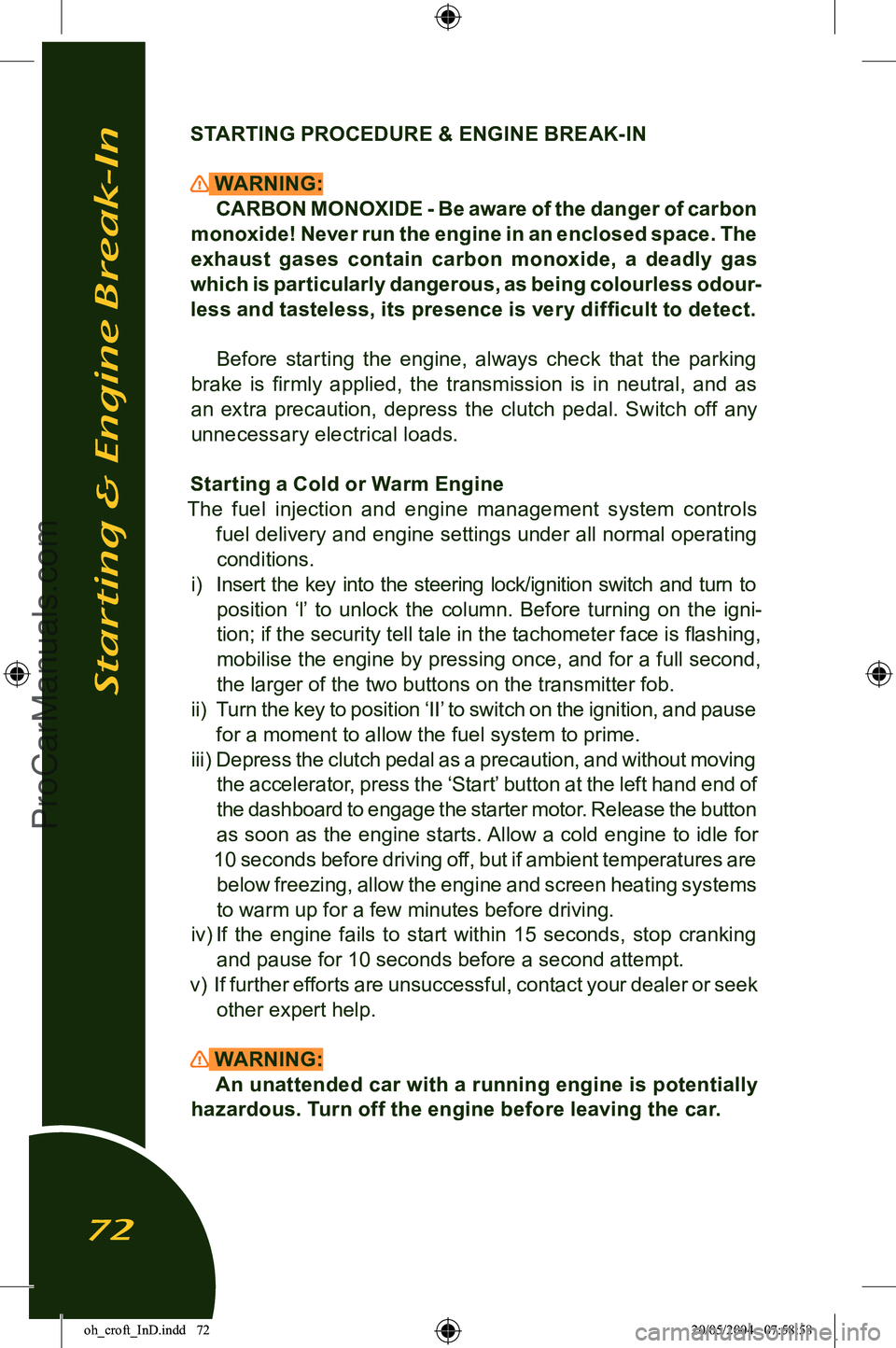
STARTING PROCEDURE & ENGINE BREAK-IN
WARNING:CARBON MONOXIDE - Be aware of the danger of carbon
monoxide! Never run the engine in an enclosed space. The
exhaust gases contain carbon monoxide, a deadly gas
which is particularly dangerous, as being colourless odour
-
less and tasteless, its presence is very difficult to detect.
Before starting the engine, always check that the parking
brake is firmly applied, the transmission is in neutral, and as
an extra precaution, depress the clutch pedal. Switch off any
unnecessary electrical loads.
Starting a Cold or Warm Engine
The fuel injection and engine management system controls fuel delivery and engine settings under all normal operating conditions.
i) Insert the key into the steering lock/ignition switch and turn to
position ‘l’ to unlock the column. Before turning on the igni
-
tion; if the security tell tale in the tachometer face is flashing, mobilise the engine by pressing once, and for a full second,
the larger of the two buttons on the transmitter fob.
ii) Turn the key to position ‘II’ to switch on the ignition, and pause
for a moment to allow the fuel system to prime.
iii) Depress the clutch pedal as a precaution, and without moving
the accelerator, press the ‘Start’ button at the left hand end of
the dashboard to engage the starter motor. Release the button
as soon as the engine starts. Allow a cold engine to idle for
10 seconds before driving off, but if ambient temperatures are below freezing, allow the engine and screen heating systems
to warm up for a few minutes before driving.
iv) If the engine fails to start within 15 seconds, stop cranking
and pause for 10 seconds before a second attempt.
v) If further efforts are unsuccessful, contact your dealer or seek
other expert help.
WARNING:
An unattended car with a running engine is potentially
hazardous. Turn off the engine before leaving the car.
Starting & Engine Break-In
72
oh_croft_InD.indd 7220/05/2004 07:58:58ProCarManuals.com
Page 77 of 205
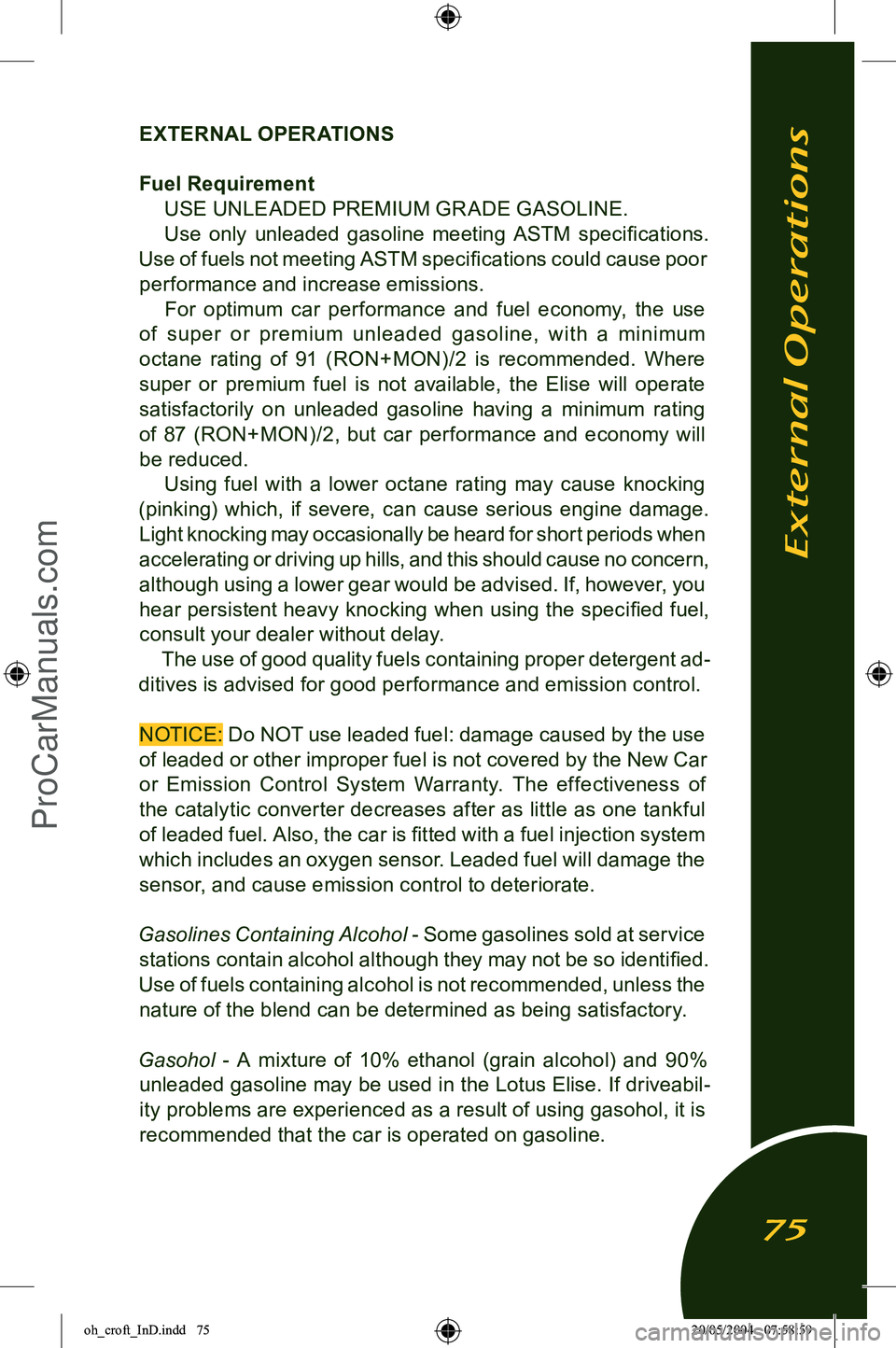
EXTERNAL OPERATIONS
Fuel Requirement USE UNLEADED PREMIUM GR ADE GASOLINE.
Use only unleaded gasoline meeting ASTM specifications.
Use of fuels not meeting ASTM specifications could cause poor performance and increase emissions.
For optimum car performance and fuel economy, the use
of super or premium unleaded gasoline, with a minimum
octane rating of 91 (RON+MON)/2 is recommended. Where
super or premium fuel is not available, the Elise will operate
satisfactorily on unleaded gasoline having a minimum rating
of 87 (RON+MON)/2, but car performance and economy will be reduced. Using fuel with a lower octane rating may cause knocking
(pinking) which, if severe, can cause serious engine damage.
Light knocking may occasionally be heard for short periods when accelerating or driving up hills, and this should cause no concern,
although using a lower gear would be advised. If, however, you hear persistent heavy knocking when using the specified fuel,
consult your dealer without delay.
The use of good quality fuels containing proper detergent ad
-
ditives is advised for good performance and emission control.
NOTICE: Do NOT use leaded fuel: damage caused by the use of leaded or other improper fuel is not covered by the New Car
or Emission Control System Warranty. The effectiveness of
the catalytic converter decreases after as little as one tankful
of leaded fuel. Also, the car is fitted with a fuel injection system
which includes an oxygen sensor. Leaded fuel will damage the sensor, and cause emission control to deteriorate.
Gasolines Containing Alcohol - Some gasolines sold at service stations contain alcohol although they may not be so identified.
Use of fuels containing alcohol is not recommended, unless the nature of the blend can be determined as being satisfactory.
Gasohol - A mixture of 10% ethanol (grain alcohol) and 90% unleaded gasoline may be used in the Lotus Elise. If driveabil
-
ity problems are experienced as a result of using gasohol, it is recommended that the car is operated on gasoline.
External Operations
75
oh_croft_InD.indd 7520/05/2004 07:58:59ProCarManuals.com
Page 78 of 205
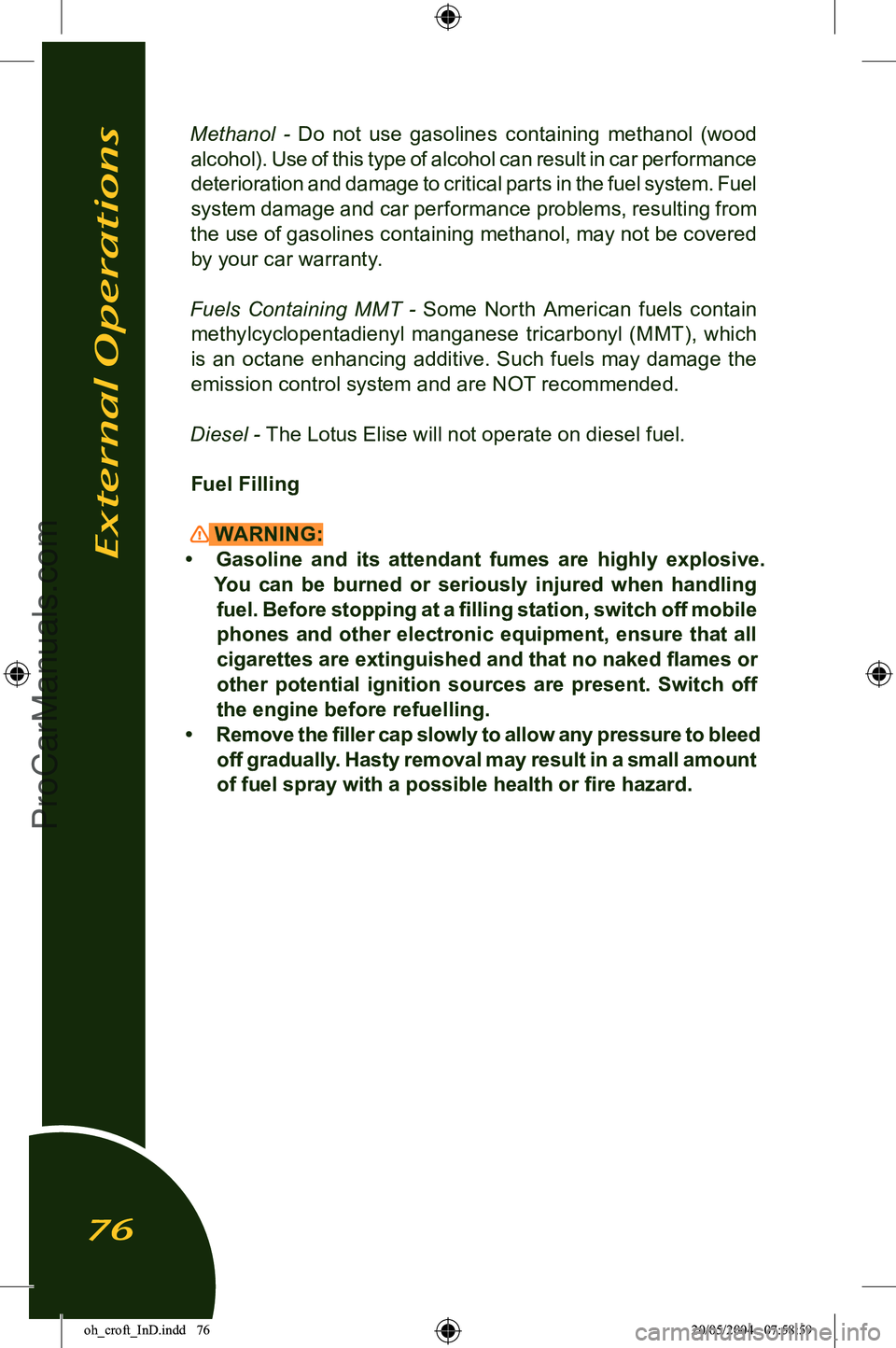
Methanol - Do not use gasolines containing methanol (wood
alcohol). Use of this type of alcohol can result in car performance deterioration and damage to critical parts in the fuel system. Fuel
system damage and car performance problems, resulting from
the use of gasolines containing methanol, may not be covered by your car warranty.
Fuels Containing MMT - Some North American fuels contain methylcyclopentadienyl manganese tricarbonyl (MMT), which
is an octane enhancing additive. Such fuels may damage the
emission control system and are NOT recommended.
Diesel
- The Lotus Elise will not operate on diesel fuel.
Fuel Filling
WARNING:
• Gasoline and its attendant fumes are highly explosive. You can be burned or seriously injured when handling
fuel. Before stopping at a filling station, switch off mobile phones and other electronic equipment, ensure that all
cigarettes are extinguished and that no naked flames or
other potential ignition sources are present. Switch off
the engine before refuelling.
• Remove the filler cap slowly to allow any pressure to bleed off gradually. Hasty removal may result in a small amount
of fuel spray with a possible health or fire hazard. External Operations
76
oh_croft_InD.indd 7620/05/2004 07:58:59ProCarManuals.com
Page 79 of 205
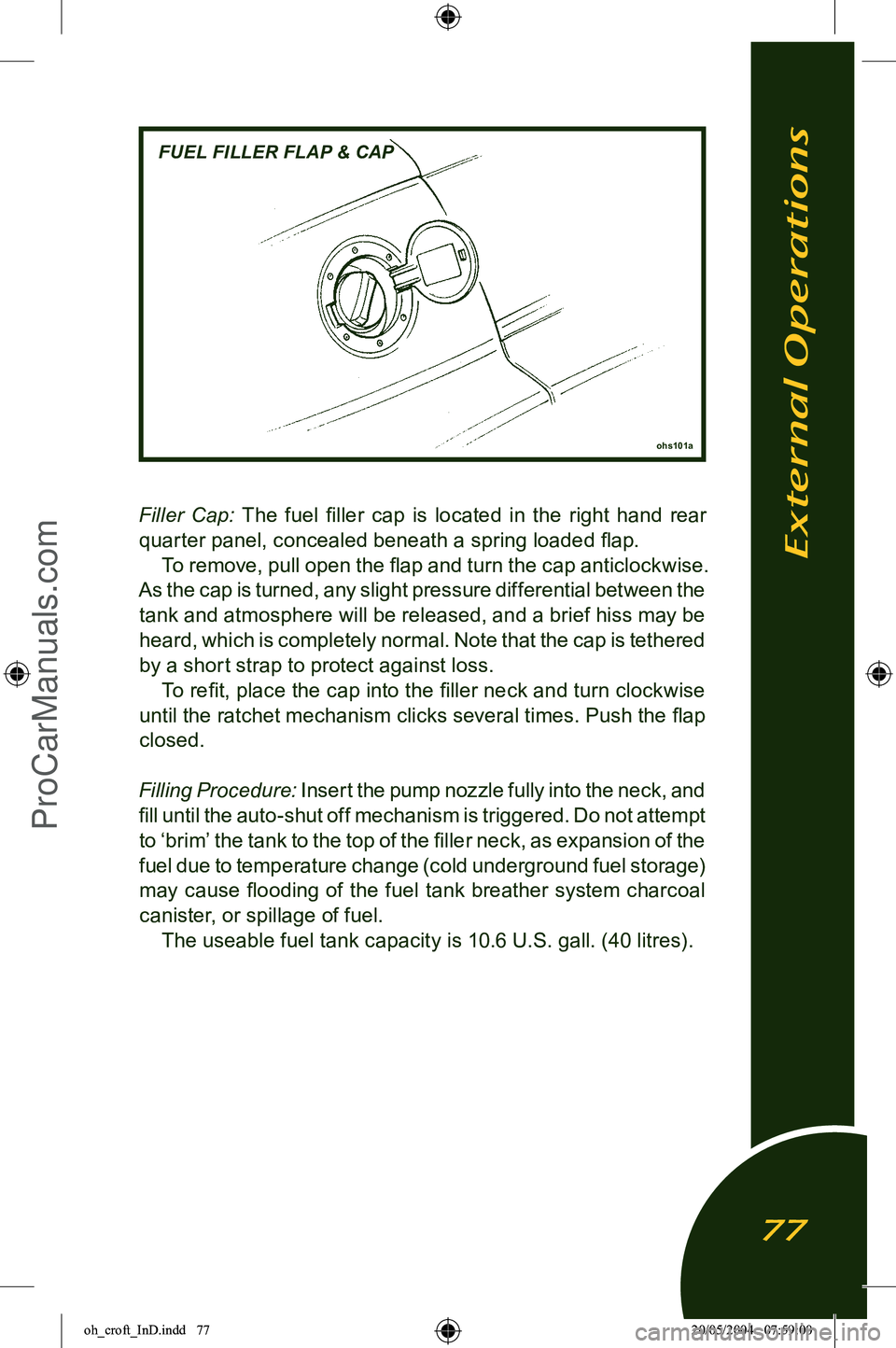
Filler Cap: The fuel filler cap is located in the right hand rear
quarter panel, concealed beneath a spring loaded flap. To remove, pull open the flap and turn the cap anticlockwise.
As the cap is turned, any slight pressure differential between the tank and atmosphere will be released, and a brief hiss may be heard, which is completely normal. Note that the cap is tethered by a short strap to protect against loss.
To refit, place the cap into the filler neck and turn clockwise
until the ratchet mechanism clicks several times. Push the flap closed.
Filling Procedure:
Insert the pump nozzle fully into the neck, and
fill until the auto-shut off mechanism is triggered. Do not attempt to ‘brim’ the tank to the top of the filler neck, as expansion of the
fuel due to temperature change (cold underground fuel storage) may cause flooding of the fuel tank breather system charcoal
canister, or spillage of fuel. The useable fuel tank capacity is 10.6 U.S. gall. (40 litres).
ohs101a
FUEL FILLER FLAP & CAP
External Operations
77
oh_croft_InD.indd 7720/05/2004 07:59:00ProCarManuals.com
Page 97 of 205

It is not recommended to store a wet car in a poorly ventilated
garage. If good ventilation cannot be provided, storage outside
on a hard standing or under a carport is to be preferred.
Paintwork Polishing Eventually some loss of gloss, and an accumulation of traffic
film, will occur. At this stage, after normal washing, the appli
-
cation of a good quality liquid polish will restore the original lustre of the paint film.
Higher gloss of the paint finish, and added protection against
contamination, can be obtained by the use of a wax polish.
However, this can only be used successfully on a clean surface,
from which the previous application has been removed with white
spirit or a liquid polish cleaner.
Washing NOTICE: Lotus recommends hand washing of the painted
bodywork. The car is a speciality sports vehicle not intended
to go through an automatic car wash. Automatic car washing machines and jet wash facilities may have a detrimental effect on the paint film and the soft top. Use of automatic car washes
will invalidate the terms of the Limited Warranty.
Many contaminants are water soluble and can be removed
before any harm occurs by thorough washing with plenty of
lukewarm water, together with a proprietary car wash additive
(Household detergent and washing up liquid can contain cor
-
rosive salts, and will remove wax and accelerate oxidation).
Frequent washing is the best safeguard against both seen and
invisible contaminants. Wash in the shade, and use a cotton chenille wash mitt or a
sponge rinsed frequently to minimise the retension of dirt parti
-
cles in the mitt or sponge. Use a straight back and forth washing motion to avoid swirled micro scratches, and rinse thoroughly.
In order to minimise degradation from road salt, the underside
of the chassis should be rinsed with clean water as soon as possible after driving on treated roads. Many fuel filling stations
offer pressure washing facilities ideal for this purpose, but do
not use on the painted bodywork or soft top roof.
Servicing & Maintenance
95
oh_croft_InD.indd 9520/05/2004 07:59:04ProCarManuals.com
Page 100 of 205
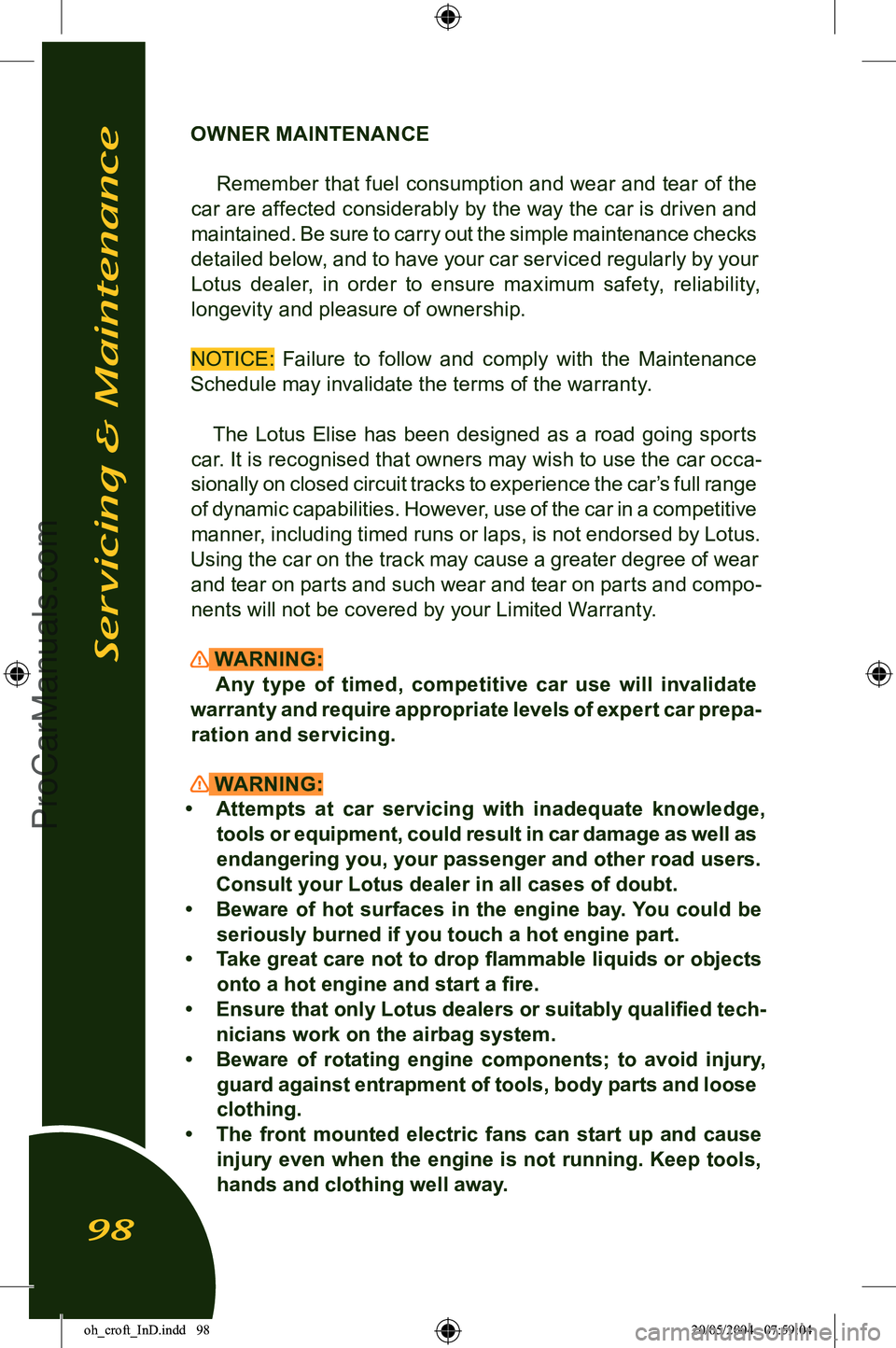
OWNER MAINTENANCERemember that fuel consumption and wear and tear of the
car are affected considerably by the way the car is driven and maintained. Be sure to carry out the simple maintenance checks detailed below, and to have your car serviced regularly by your
Lotus dealer, in order to ensure maximum safety, reliability,
longevity and pleasure of ownership.
NOTICE: Failure to follow and comply with the Maintenance
Schedule may invalidate the terms of the warranty.
The Lotus Elise has been designed as a road going sports
car. It is recognised that owners may wish to use the car occa
-
sionally on closed circuit tracks to experience the car’s full range of dynamic capabilities. However, use of the car in a competitive
manner, including timed runs or laps, is not endorsed by Lotus.
Using the car on the track may cause a greater degree of wear and tear on parts and such wear and tear on parts and compo
-
nents will not be covered by your Limited Warranty.
WARNING: Any type of timed, competitive car use will invalidate
warranty and require appropriate levels of expert car prepa
-
ration and servicing.
WARNING:
• Attempts at car servicing with inadequate knowledge, tools or equipment, could result in car damage as well as
endangering you, your passenger and other road users.
Consult your Lotus dealer in all cases of doubt.
• Beware of hot surfaces in the engine bay. You could be seriously burned if you touch a hot engine part.
• Take great care not to drop flammable liquids or objects onto a hot engine and start a fire.
• Ensure that only Lotus dealers or suitably qualified tech
-
nicians work on the airbag system.
• Beware of rotating engine components; to avoid injury,
guard against entrapment of tools, body parts and loose
clothing.
• The front mounted electric fans can start up and cause injury even when the engine is not running. Keep tools,
hands and clothing well away.
Servicing & Maintenance
98
oh_croft_InD.indd 9820/05/2004 07:59:04ProCarManuals.com
Page 101 of 205
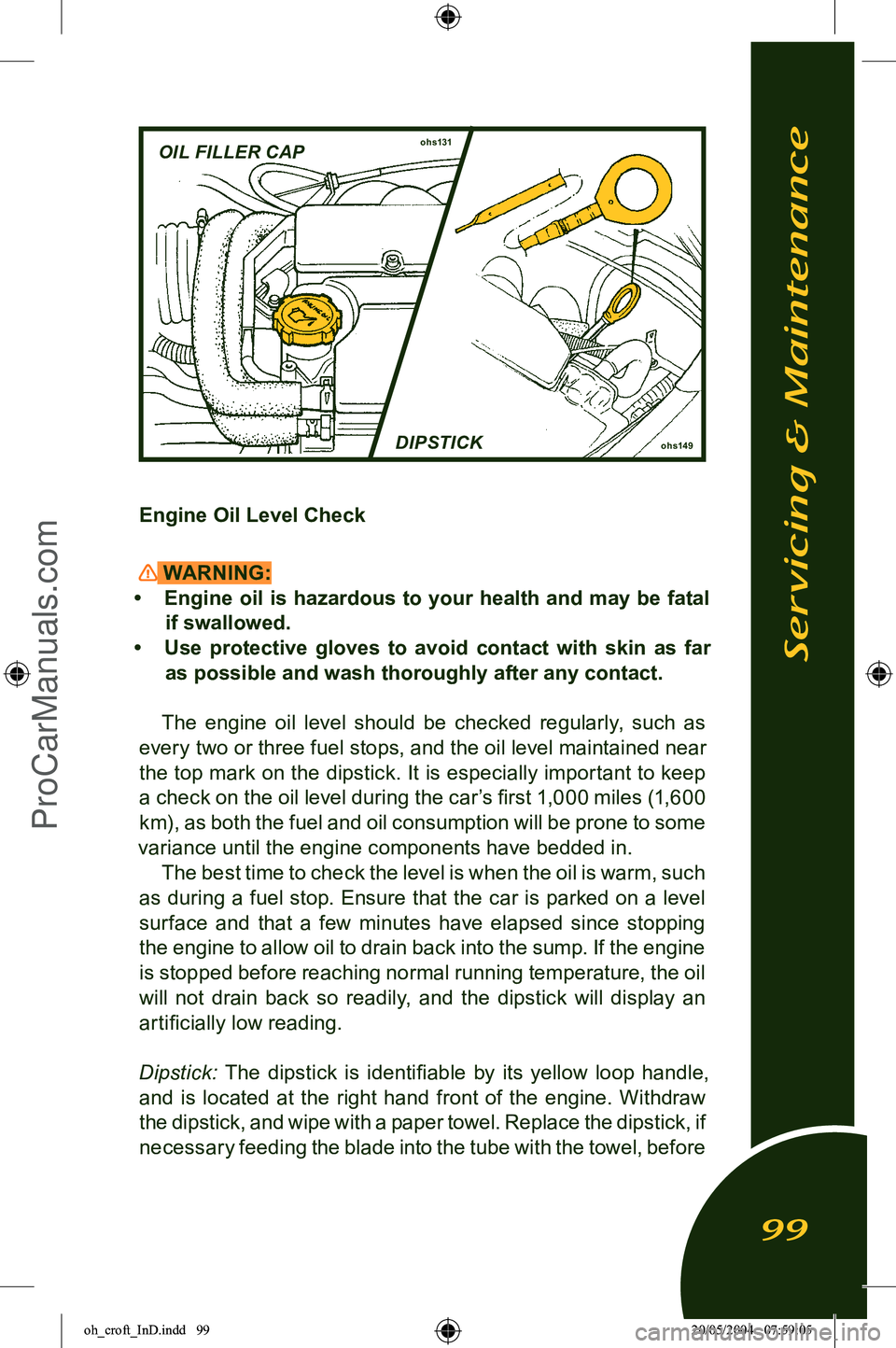
ohs149
OIL FILLER CAPohs131
DIPSTICK
Engine Oil Level Check
WARNING:
• Engine oil is hazardous to your health and may be fatal
if swallowed.
• Use protective gloves to avoid contact with skin as far as possible and wash thoroughly after any contact.
The engine oil level should be checked regularly, such as
every two or three fuel stops, and the oil level maintained near
the top mark on the dipstick. It is especially important to keep a check on the oil level during the car’s first 1,000 miles (1,600
km), as both the fuel and oil consumption will be prone to some
variance until the engine components have bedded in. The best time to check the level is when the oil is warm, such
as during a fuel stop. Ensure that the car is parked on a level
surface and that a few minutes have elapsed since stopping
the engine to allow oil to drain back into the sump. If the engine is stopped before reaching normal running temperature, the oil
will not drain back so readily, and the dipstick will display an artificially low reading.
Dipstick: The dipstick is identifiable by its yellow loop handle,
and is located at the right hand front of the engine. Withdraw
the dipstick, and wipe with a paper towel. Replace the dipstick, if necessary feeding the blade into the tube with the towel, before
Servicing & Maintenance
99
oh_croft_InD.indd 9920/05/2004 07:59:05ProCarManuals.com
Page 120 of 205

Use a good quality proprietary tire pressure gauge and always replace the tire valve dust cap to prevent the
ingress of dirt and moisture into the valve, which could cause leakage. Many fuel filling stations provide tire inflation facilities,
which specific usage instructions should be carefully fol
-
lowed. For tire pressure information, refer to ‘Technical
Data’ or the Certification Label on the driver’s door jamb
(see page 121).
Replacement Tires When replacing tires, refer to the ‘Technical Data’ sec
-
tion in this handbook, or consult your dealer to check the current Lotus specification and recommendations. Do not
use tires which differ from these specifications.
WARNING: Note that some tread patterns are directional, so
that the tire must be fitted onto the wheel with regard
to which side of the car the wheel is to be used. In
these cases, a direction of rotation arrow is included in the tire sidewall markings.
When balancing the wheel and tire assemblies, the
wheels should be located by the centre spigot hole - NOT by the wheel bolt holes. In order to maintain the correct
ohs115b
Direction of rotation arrow
Tires & Wheels
118
oh_croft_InD.indd 11820/05/2004 07:59:10ProCarManuals.com
Page 124 of 205
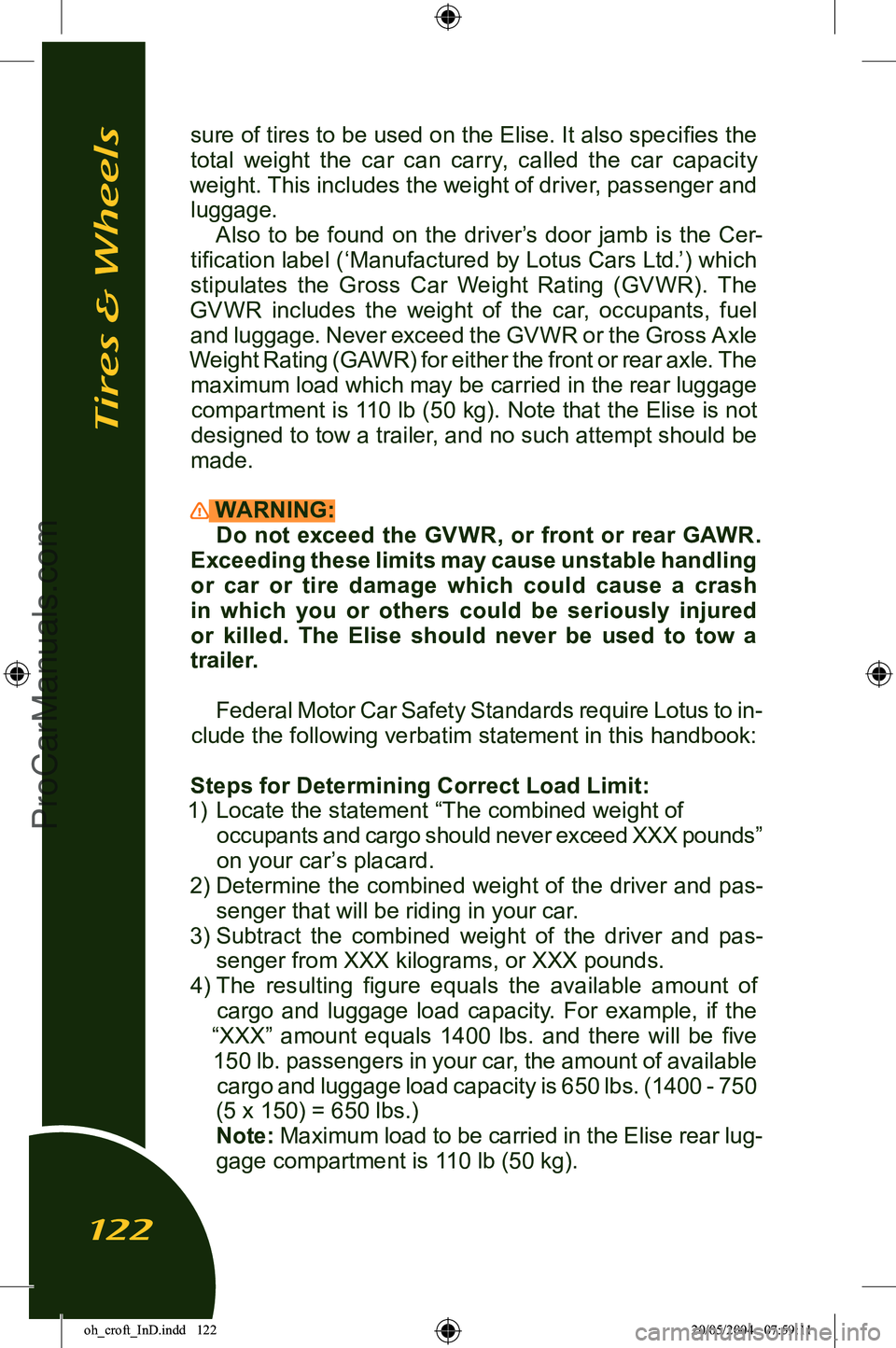
sure of tires to be used on the Elise. It also specifies the total weight the car can carry, called the car capacity
weight. This includes the weight of driver, passenger and luggage. Also to be found on the driver’s door jamb is the Cer
-
tification label (‘Manufactured by Lotus Cars Ltd.’) which stipulates the Gross Car Weight Rating (GV WR). The
GVWR includes the weight of the car, occupants, fuel and luggage. Never exceed the GVWR or the Gross Axle
Weight Rating (GAWR) for either the front or rear axle. The maximum load which may be carried in the rear luggage compartment is 110 lb (50 kg). Note that the Elise is not designed to tow a trailer, and no such attempt should be
made.
WARNING: Do not exceed the GVWR, or front or rear GAWR.
Exceeding these limits may cause unstable handling or car or tire damage which could cause a crash
in which you or others could be seriously injured or killed.
The Elise should never be used to tow a
trailer.
Federal Motor Car Safety Standards require Lotus to in
-
clude the following verbatim statement in this handbook:
Steps for Determining Correct Load Limit:
1) Locate the statement “The combined weight of occupants and cargo should never exceed XXX pounds”
on your car’s placard.
2) Determine the combined weight of the driver and pas
-
senger that will be riding in your car.
3) Subtract the combined weight of the driver and pas
-
senger from XXX kilograms, or XXX pounds.
4) The resulting figure equals the available amount of cargo and luggage load capacity. For example, if the
“XXX” amount equals 1400 lbs. and there will be five 150 lb. passengers in your car, the amount of available cargo and luggage load capacity is 650 lbs. (1400 - 750
(5 x 150) = 650 lbs.)
Note: Maximum load to be carried in the Elise rear lug-
gage compartment is 110 lb (50 kg).
Tires & Wheels
122
oh_croft_InD.indd 12220/05/2004 07:59:11ProCarManuals.com
Page 135 of 205

‘Jump’ StartingIf the battery becomes discharged to the extent that the en
-
gine cannot be started, proprietary good quality ‘jumper cables’ may be used to connect with the battery of a second car in order
to provide the energy necessary for starting.
WARNING: It is most important that the correct procedure is fol
-
lowed in order to avoid damage to either car’s electrical system, and most importantly, to minimise the danger of a
spark induced battery explosion. Check that the slave car
also has a NEGATIVE EARTH electrical system.
i) With the engine of the slave car running at a fast idle, use one jumper cable (red) to connect the positive (+) terminal of
one battery to the positive terminal of the other battery. Take
care during this process to avoid inadvertently earthing a free end of this cable to the metal body or chassis of either car.
ii) Connect one end of the other jumper cable (black) to the negative (-) terminal of the discharged battery.
iii) A spark will occur when the other end of this cable (the final connection) is connected to an earth on the slave car. This
connection should therefore be made to a point away from
the battery, and away from any fuel vapour area or moving
parts. An engine hanger bracket is often ideal.
iv) Start the car in the usual way, and run at a fast idle.
ohs14c
JUMP STARTING
Electrical
133
oh_croft_InD.indd 13320/05/2004 07:59:14ProCarManuals.com